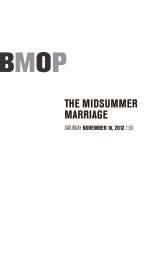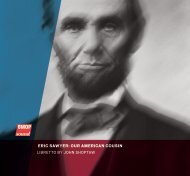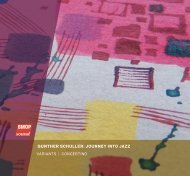Download the album booklet - Boston Modern Orchestra Project
Download the album booklet - Boston Modern Orchestra Project
Download the album booklet - Boston Modern Orchestra Project
Create successful ePaper yourself
Turn your PDF publications into a flip-book with our unique Google optimized e-Paper software.
In recent years, I’ve also become drawn to <strong>the</strong> use of collage and quotation, ano<strong>the</strong>r sort<br />
of time travel, using fragments of pre-existing music as compositional springboards.<br />
snippets of <strong>the</strong>se found-sound passages are frequently combined to form tone-rows,<br />
which in turn generate melodic lines, chords, and rapid, busy figurations. <strong>the</strong> quoted<br />
materials may also rise to <strong>the</strong> surface, Ives-like, in reasonably recognizable shapes.<br />
In each of <strong>the</strong> concertos, <strong>the</strong>se concerns converge. <strong>the</strong>re is a decided <strong>the</strong>atrical focus to<br />
three of <strong>the</strong>m: for <strong>the</strong> double bass concerto, members of <strong>the</strong> orchestra must leave <strong>the</strong>ir<br />
seats, walk to <strong>the</strong> percussion section and beat quietly on drums; <strong>the</strong> saxophone soloist<br />
of <strong>the</strong> fourth concerto changes location frequently, joining various sub-sections of <strong>the</strong><br />
ensemble; in <strong>the</strong> sixth (violin) concerto, <strong>the</strong> flutist walks to <strong>the</strong> harpsichord, engaging in a<br />
duet spatially separated from <strong>the</strong> rest of <strong>the</strong> orchestra.<br />
eclectic overlay of style and reference to pre-existing music informs <strong>the</strong> texture of all six<br />
works. homages to tchaikovsky and sibelius dominate <strong>the</strong> first (double bass) concerto,<br />
and aspects of <strong>the</strong> second (clarinet) concerto are meant to evoke memories of mahler and<br />
brahms. <strong>the</strong> third (piano) concerto grew out of an obsession with repeated-note figurations<br />
and decorations, but evolved into an extended “essay” on ralph Vaughan williams,<br />
<strong>the</strong> subject of my doctoral <strong>the</strong>sis. (a phrase from <strong>the</strong> rVw two-piano concerto puts in a<br />
brief appearance.) this concerto’s subtitle Ano<strong>the</strong>r view is quite literal; for this recording,<br />
and for <strong>the</strong> bmop performance that preceded it, I took a long look at my 1977 score, pulled<br />
it apart and reconstructed it.<br />
I began work on <strong>the</strong> fourth (saxophone) concerto in 1980, after hearing a lecture on <strong>the</strong><br />
music of michael tippett, and so decided to start my piece with what seemed—at <strong>the</strong><br />
time—<strong>the</strong> densest imaginable fabric: five separate musical motives stated simultaneously.<br />
as <strong>the</strong> texture unravels, each of <strong>the</strong> motives becomes an individual element in <strong>the</strong><br />
overall narrative. <strong>the</strong> initial impetus for <strong>the</strong> bassoon concerto, sub-titled Water music,<br />
6<br />
GIlbert stuart, thomAs jefferson, C.1821, natIonal portraIt Gallery, washInGton, dC (photo: brIan r. paGe)










